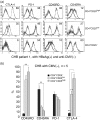Circulating CD4+ CD25+ regulatory T cells correlate with chronic hepatitis B infection
- PMID: 17764450
- PMCID: PMC2433275
- DOI: 10.1111/j.1365-2567.2007.02691.x
Circulating CD4+ CD25+ regulatory T cells correlate with chronic hepatitis B infection
Abstract
Circulating CD4+ CD25+ regulatory T cells (Tregs) have been demonstrated to maintain immunotolerance and suppress the antigen-specific or antigen-non-specific T-cell responses, but their role in chronic hepatitis B (CHB) infection in humans has not been well characterized. In this study, we analysed the frequency and phenotypic characteristics of CD4+ CD25+ Tregs in patients of different hepatitis B virus (HBV) infection status, and investigated the effect of Tregs on antiviral immune responses in CHB patients, and the mechanism of this effect. A total of 137 subjects, including 79 CHB patients, 26 asymptomatic HBV carriers (ASCs), 12 acute hepatitis B (AHB) patients and 20 healthy controls, were enrolled in the study. We found that the frequency of CD4+ CD25(high) Tregs in AHB patients was comparable to that in healthy controls, while it was significantly increased in CHB patients. CD4+ CD25+ Tregs produced interleukin (IL)-10 but little or no interferon (IFN)-gamma under anti-CD3 stimulation. In CHB patients, the frequency of CD4+ CD25(high) Tregs positively correlated with serum viral load, and the Tregs were capable of suppressing the proliferation and IFN-gamma production of autologous peripheral blood mononuclear cells (PBMC) mediated by HBV antigen stimulation in vitro. However, combined administration of anti-programmed death-1 (PD-1) and anti-cytotoxic lymphocyte antigen-4 (CTLA-4) monoclonal antibody slightly enhanced the cellular proliferation and significantly increased the IFN-gamma production of PBMC cocultured with Tregs at a ratio of 2:1. Thus, the frequency of circulating CD4+ CD25+ Tregs is increased in patients with CHB, and this may play an important role in viral persistence by modulating virus-specific immune responses.
Figures






Similar articles
-
Circulating and liver resident CD4+CD25+ regulatory T cells actively influence the antiviral immune response and disease progression in patients with hepatitis B.J Immunol. 2006 Jul 1;177(1):739-47. doi: 10.4049/jimmunol.177.1.739. J Immunol. 2006. PMID: 16785573
-
Regulatory T cells in chronic hepatitis B patients affect the immunopathogenesis of hepatocellular carcinoma by suppressing the anti-tumour immune responses.J Viral Hepat. 2010 Mar;17 Suppl 1:34-43. doi: 10.1111/j.1365-2893.2010.01269.x. J Viral Hepat. 2010. PMID: 20586932
-
Interleukin-35 Suppresses Antiviral Immune Response in Chronic Hepatitis B Virus Infection.Front Cell Infect Microbiol. 2017 Nov 13;7:472. doi: 10.3389/fcimb.2017.00472. eCollection 2017. Front Cell Infect Microbiol. 2017. PMID: 29181338 Free PMC article.
-
Immune Regulation by T Regulatory Cells in Hepatitis B Virus-Related Inflammation and Cancer.Scand J Immunol. 2017 Mar;85(3):175-181. doi: 10.1111/sji.12524. Scand J Immunol. 2017. PMID: 28109025 Review.
-
Significant roles of regulatory T cells and myeloid derived suppressor cells in hepatitis B virus persistent infection and hepatitis B virus-related HCCs.Int J Mol Sci. 2015 Feb 3;16(2):3307-22. doi: 10.3390/ijms16023307. Int J Mol Sci. 2015. PMID: 25654227 Free PMC article. Review.
Cited by
-
Immunopathogenesis of hepatitis B persistent infection: implications for immunotherapeutic strategies.Clin J Gastroenterol. 2009 Apr;2(2):71-79. doi: 10.1007/s12328-009-0074-z. Epub 2009 Mar 27. Clin J Gastroenterol. 2009. PMID: 26192169
-
Targeting T regulatory (Treg) cells in immunotherapy-resistant cancers.Cancer Drug Resist. 2024 Jan 12;7:2. doi: 10.20517/cdr.2023.46. eCollection 2024. Cancer Drug Resist. 2024. PMID: 38318526 Free PMC article. Review.
-
Hepatitis B virus infection: An insight into the clinical connection and molecular interaction between hepatitis B virus and host extrahepatic cancer risk.Front Immunol. 2023 Mar 1;14:1141956. doi: 10.3389/fimmu.2023.1141956. eCollection 2023. Front Immunol. 2023. PMID: 36936956 Free PMC article. Review.
-
Circulating Tregs correlate with viral load reduction in chronic HBV-treated patients with tenofovir disoproxil fumarate.J Clin Immunol. 2011 Jun;31(3):509-20. doi: 10.1007/s10875-011-9509-7. Epub 2011 Feb 9. J Clin Immunol. 2011. PMID: 21305387
-
Amphiregulin promotes the immunosuppressive activity of intrahepatic CD4+ regulatory T cells to impair CD8+ T-cell immunity against hepatitis B virus infection.Immunology. 2015 Mar;144(3):506-517. doi: 10.1111/imm.12400. Immunology. 2015. PMID: 25298208 Free PMC article.
References
-
- Maini MK, Boni C, Ogg GS, et al. Direct ex vivo analysis of hepatitis B-virus specific CD8+ T cells associated with the control of infection. Gastroenterology. 1999;117:1386–96. - PubMed
-
- Sakaguchi S, Sakaguchi N, Asano M, Itoh M, Toda M. Immunologic self-tolerance maintained by activated T cells expressing IL-2 receptor alpha-chains (CD25): breakdown of a single mechanism of self-tolerance causes various autoimmune diseases. J Immunol. 1995;155:1151–64. - PubMed
-
- Mills KH, McGuirk P. Antigen-specific regulatory T cells – their induction and role in infection. Semin Immunol. 2004;16:107–17. - PubMed
-
- Vigouroux S, Yvon E, Biagi E, Brenner MK. Antigen-induced regulatory T cells. Blood. 2004;104:26–33. - PubMed
MeSH terms
Substances
LinkOut - more resources
Full Text Sources
Other Literature Sources
Medical
Research Materials

